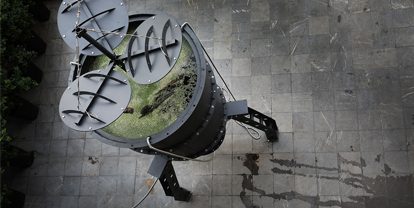“Time Capsule” series, pt. III, “Eukaryotes, Remember!”
Amir-Nasr Kamgooyan
November 23 — December 21, 2018
Three towering mirrors installed 5 meters above ground, give three separate reflections of one narrative: a man-made pond in a cone-shaped structure. There is always a distance between the observer and the ecosystem. Three different views of a wetland in which a community of different species live. In this third episode of his “Time Capsule” series called “Eukaryotes, Remember!”, Amir-Nasr Kamgooyan recreates the ecosystem of a swamp in an uncanny structure in Mohsen Galley’s front yard, i.e. Hayat: a proper use of the space to protect an environment on which species depend in order to survive.
In Amir-Nasr Kamgooyan’s works, traces of ancient literature and science can clearly be found. He seems to be infatuated with the dichotomies between the progressive and the primitive, the mechanical and the organic, as well as the contrast between knowledge and forgetfulness. His earlier “The Memory of the Pond” and the recent “Eukaryotes, Remember!” make references to The Three Princes of Serendip by Michele Tramezzino (adapted from Amir Khusrau’s Hasht-Bihisht), implying serendipity or happy chance. By recreating an ecosystem and its reflection on three mirrors, the structure challenges the viewers’ visual field.
Visual perception is the most recent development in humans’ evolutionary process. In comparison to other sense organs, such as the ear and the nose, the eye sends more information to the nervous system. Receptors play a crucial role in the formation of various perceptual worlds. The visual world, for instance, is vastly different from the aural world, and visual perceptions are more clear that auditory ones. Moreover, there is a difference between how visual information is perceived from the image of the visual world on the retina. The visual field consists of an array of color and light patterns formed on the retina, used by human beings to create their visual worlds. However, the retinal sensory stimulation is different from what it perceived. The retina consists of three parts. Each one of these parts carry out different duties in the visual process, so that the observer sees things in three different ways: sensitivity to light, sensitivity to colors, and the place on which the peripheral vision is formed.
Amir-Nasr Kamgooyan’s project “Eukaryotes, Remember!” from his “Time Capsule” series is installed in Mohsen Gallery’s Hayat. The Hayat Project is an open space in Mohsen Gallery that interacts with the city and invites the audience to go beyond the boundaries of everyday life.
